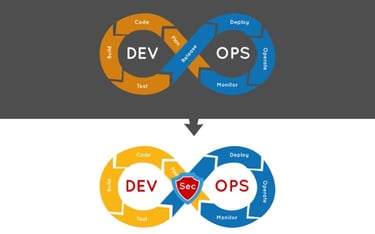
DevOps is an everyday term that is associated with profit, progress and fruitful business. While some of the benefits it offers include better collaboration between teams, faster time to market, improved productivity and enhanced customer satisfaction, it is still devoid of one essential factor -security, which makes it a little short of progress.
DevSecOps could be a healthy switch if security is prioritized, which should be the key aim of businesses when they look forward to making changes in their operations. Having said that, it would be wrong to say that there was absolutely no security check in the product development stages. Before the advent of DevOps solutions and services, organizations executed their security check at the end of the development stage, which means if there was a security threat that was detected, the entire software had to be reworked upon. This, in turn, would mean a loss of time and money. This was when patching came into being, a traditional way of ensuring that there would not be any security threats in the future.
Why it’s Important to Switch to DevSecOps
The IT industry has evolved in a massive way, demanding a plethora of changes in the way security is being perceived. However, businesses are yet to gauge the importance of security even in a DevOps environment, thus giving rise to the cybercrime attacks. According to a report by Juniper Research, a single data breach in a business can cost up to $150 million by the year 2020. Implementing DevSecOps has an appositive impact as it helps in managing these devastating challenges.
DevSecOps and its Implications
The system involves incorporating security practices into an organization’s existing DevOps solutions. The main goal of this practice is to introduce a security filter in every stage of the software development workflow. This is particularly helpful because the security check is not saved for the last stage of the development, which often turns out to be time and money-consuming.
If businesses are running on traditional software, a direct shift to DevSecOps would be economical; however, if they are already functioning on the principle of DevOps, it could be time and resource-consuming, but fruitful at the end.
DevSecOps, in every way, if backward-looking, unlike its counterpart DevOps. The security integration looks backward to analyze and predict future issues, the DevOps is forward-looking because it aims at rapid development. By prioritizing security automation and analysis, teams can still improve delivery speed without the need to look for threats separately.
Benefits of DevSecOps
Easy and Automatic Code Procurement: It helps in eliminating the problem of human error and incorporating weakened or flawed coding. This helps in detecting vulnerabilities and flaws to be detected earlier in the process.
High-End Security Resources: DevSecOps addresses areas related to threat assessment, code security, and event monitoring. This frees the IT or the security team from a lot of work and lets them focus on other areas like threat remediation and elimination.
Uninterrupted Deployment of Security: DevSecOps ensures uninterrupted security deployment through the use of real-time automation tools. This is done by creating closed-loop testing and reporting and real-time threat resolution.
How to Achieve DevSecOps?
By Scanning Vulnerability: It is the basic first step for securing the products. With DevSecOps, the checking is done at every major stage of the delivery pipeline. To ensure that DevSecOps is successful at every stage of implementation, it is important that the parties responsible for these various stages of the pipeline have the training and tools they need to detect vulnerabilities in the code.
By providing Runtime Protection: It is another important pre-requisite for integrating DevSecOps strategy. Runtime protection means securing the software against threats that can arise when the application starts running.
By using the Security offered by the Cloud Service Provider: It is always beneficial to have a security system in place before integrating DevSecOps. Many of these tools are placed in the deployment and the post-deployment stage of the DevOps chain, akin to the traditional methods of integrating security features in the development pipeline. However, they still serve as a part of the application’s outer defenses. Moreover, they are part of the cloud infrastructure, which makes it easy to operate and systematize.
For more detailed information about DevSecOps and other DevOps, technology Talk to our Experts